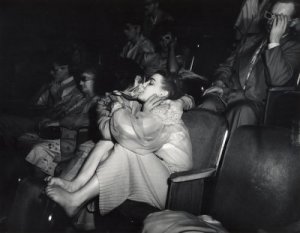PORTLAND, Ore. - (June 16, 2010) - Photos by "Weegee" - a photojournalist of the 1930s and ‘40s - depict the gritty reality of New York street life. Crime scenes, urban life, street kids and emerging countercultures produced black-and-white images that were both shocking and beautiful.
Despite the lapse in time, the photos still resonate in today's urban landscape. An exhibit, "The More Things Change ... Relocating Weegee Photographs," will be exhibited July 1 to July 30 at the White Box visual laboratory in Portland, and will include a collector's talk that shares personal insight into the artist.
"This exhibit is a look back to a photographic record of a particular time and place that resonates with the UO in Portland's own urban location in Old Town Chinatown. Weegee's images are gritty and disturbing, yet still manage to capture the raw human beauty of life in the city," said Kate Wagle, director of Portland programs for the University of Oregon's School of Architecture and Allied Arts.
Arthur Fellig was an untrained photojournalist who followed the New York emergency services to capture activity of the city. With a police radio and a portable darkroom in his car he could follow crime as it happened. His nickname, "Weegee the Famous," is a reference to the Ouija board game for Fellig's apparent knack of knowing when a story would break.
The exhibit at the UO's White Box will include 21 photos with images of city street life, summer in the city, transgendered culture, homelessness and new communities. The show will be open from 6 p.m. to 9 p.m. July 1 for First Thursday.
"Taken during an era of rapid change in New York City, we now see many of the same compelling images that define our neighborhood today: images of despair, struggle and hope," Wagle said.
The exhibit is on loan from the Ellen and Alan Newberg collection. The two will give a collector's talk and slide show from 5:30 p.m. to 6:30 p.m. on Thursday, July 29, at the White Box. The photographs came to the Newbergs via Ellen's aunt, Wilma Wilcox, who was a close confidant, assistant and life partner to Weegee for more than 30 years of his later life. The Newbergs will share their personal stories, thoughts and observations about Weegee and his photographic career. The event is free and open to the public.
A related exhibition, "Weegee the Famous," is currently on display through Aug. 15 at the Jordan Schnitzer Museum of Art at the University of Oregon in Eugene. The Newbergs will give a collectors' talk at the museum on Wednesday, July 28. For more information, visit jsma.uoregon.edu.
The White Box exhibit is sponsored by UO in Portland, the UO School of Architecture and Allied Arts, and the UO Arts Administration Program.
The White Box is a 1,500-square-foot visual laboratory that allows students, faculty, regional and national communities to research, explore and present global issues in art and design. The White Box is located at 24 NW First Ave, on the ground floor of the White Stag Block. It is open from noon to 6 p.m. Tuesdays through Saturdays, during the period when an exhibition is scheduled. Admission is free.
About the University of Oregon
The University of Oregon is a world-class teaching and research institution and Oregon's flagship public university. The UO is a member of the Association of American Universities (AAU), an organization made up of the 63 leading public and private research institutions in the United States and Canada. The University of Oregon is one of only two AAU members in the Pacific Northwest.
Contact: Heidi Hiaasen, UO in Portland communications, 503-412-3714, heidih@uoregon.edu
Links: University of Oregon in Portland: pdx.uoregon.edu
Image: "Movie Ecstasy - The Kiss" (1943) by Weegee the Famous (Arthur Fellig), Courtesy of Alan and Ellen Newberg and in memory of Wilma Wilcox.